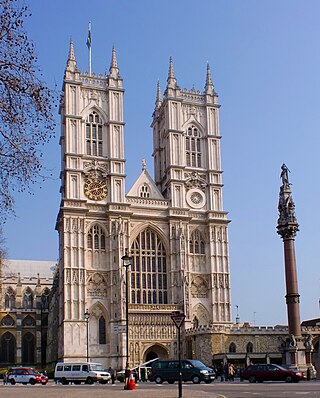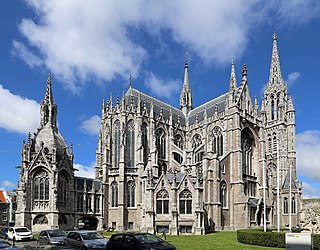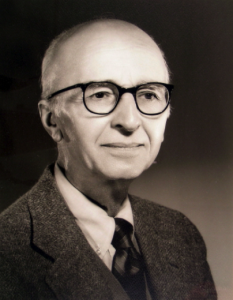Related Research Articles

Westminster Abbey, formally titled the Collegiate Church of Saint Peter at Westminster, is an Anglican church in the City of Westminster, London, England. Since 1066, it has been the location of the coronations of 40 English and British monarchs and a burial site for 18 English, Scottish, and British monarchs. At least 16 royal weddings have taken place at the abbey since 1100.

Gothic Revival is an architectural movement that after a gradual build-up beginning in the second half of the 17th century became a widespread movement in the first half of the 19th century, mostly in England. Increasingly serious and learned admirers sought to revive medieval Gothic architecture, intending to complement or even supersede the neoclassical styles prevalent at the time. Gothic Revival draws upon features of medieval examples, including decorative patterns, finials, lancet windows, and hood moulds. By the middle of the 19th century, Gothic Revival had become the pre-eminent architectural style in the Western world, only to begin to fall out of fashion in the 1880s and early 1890s.

The Cathedral Church of St Peter and St Wilfrid, commonly known as Ripon Cathedral, and until 1836 known as Ripon Minster, is a cathedral in Ripon, North Yorkshire, England. Founded as a monastery by monks of the Irish tradition in the 660s, it was refounded as a Benedictine monastery by St Wilfrid in 672. The church became collegiate in the tenth century, and acted as a mother church within the large Diocese of York for the remainder of the Middle Ages. The present church is the fourth, and was built between the 13th and 16th centuries. In 1836 the church became the cathedral for the Diocese of Ripon. In 2014 the Diocese was incorporated into the new Diocese of Leeds, and the church became one of three co-equal cathedrals of the Bishop of Leeds.

Bristol Cathedral, formally the Cathedral Church of the Holy and Undivided Trinity, is a Church of England cathedral in the city of Bristol, England. It is the seat of the Bishop of Bristol. The cathedral was originally an abbey dedicated to St Augustine, founded in 1140 and consecrated in 1148. It became the cathedral of the new diocese of Bristol in 1542, after the dissolution of the monasteries. It is a Grade I listed building.

Wells Cathedral is an Anglican cathedral in Wells, Somerset, England, dedicated to St Andrew the Apostle. It is the seat of the Bishop of Bath and Wells, whose cathedra it holds as mother church of the Diocese of Bath and Wells. Built as a Roman Catholic cathedral from around 1175 to replace an earlier church on the site since 705, it became an Anglican cathedral when King Henry VIII split from Rome. It is moderately sized for an English cathedral. Its broad west front and large central tower are dominant features. It has been called "unquestionably one of the most beautiful" and "most poetic" of English cathedrals.

Ely Cathedral, formally the Cathedral Church of the Holy and Undivided Trinity, is an Anglican cathedral in the city of Ely, Cambridgeshire, England.

Norwich Cathedral, formally the Cathedral Church of the Holy and Undivided Trinity, is a Church of England cathedral in the city of Norwich, Norfolk, England. The cathedral is the seat of the bishop of Norwich and the mother church of the diocese of Norwich. It is administered by its dean and chapter, and there are daily Church of England services. It is a Grade I listed building.

Walstan was an Anglo-Saxon prince, known for the miracles which occurred during and after his life after he became a farm worker. He is a patron saint of farm animals and agricultural workers, who once visited his shrine at the church at Bawburgh, in the English county of Norfolk. Two sources for his life exist: the De Sancto Walstano Confessore in the Nova Legenda Angliæ, printed by Wynkyn de Worde in 1516, and known as the English Life; and a later Latin manuscript copied in 1658 from a now lost medieval triptych, now in the Lambeth Palace library in London.

Osbert Parsley was an English Renaissance composer and chorister. Few details of his life are known, but he evidently married in 1558, and lived for a period in the parish of St Saviour's Church, Norwich. A boy chorister at Norwich Cathedral, Parsley worked there throughout his musical career. He was first mentioned as a lay clerk, was appointed a "singing man" in c. 1534, and was probably the cathedral's unofficial organist for half a century. His career spanned the reigns of Henry VIII and all three of his children. After the Reformation of 1534, the lives of English church musicians changed according to the official policy of each monarch.
Lindy M. Grant,, is professor emerita of medieval history at the University of Reading, an honorary research fellow of the Courtauld Institute of Art, and a former president of the British Archaeological Association. Grant is a specialist in Capetian France and its neighbours in the 11th to 13th centuries.

Jean Victor Edmond Paul Marie Bony was a French medieval architectural historian specialising in Gothic architecture. He was Slade Professor of Fine Art at the University of Cambridge from 1958 to 1961, Fellow of St John's College, Cambridge, and Professor of Art at the University of California at Berkeley, from 1962 to 1980.
Peter Kidson was a British Emeritus Professor and Honorary Fellow at the Courtauld Institute of Art where he lectured on Medieval Architecture until 1990. In his obituary in The Telegraph, he was described as “the most influential historian of medieval architecture of his generation in the English-speaking world”.
Carolyn Marino Malone is an American medievalist and academic. She is professor of art history and history at USC Dornsife College, Los Angeles, California, with a PhD in Art History and Medieval Studies (1973) from the University of California, Berkeley. Her research interests are English and French Romanesque and Gothic architecture and sculpture. She has published books on sculptural finds at Canterbury Cathedral, the abbey of St Bénigne in Dijon, the façade of Wells Cathedral, and monastic life in the Middle Ages. She served as Vice-President (1996-1997) and President (1999) of Art Historians of Southern California; Domestic Advisor to the Board of Directors of the International Center of Medieval Art (1984-1987); and was on the board of directors of the Medieval Association of the Pacific (1986-1989). She is a member of the Society of Architectural Historians.
Francis P. Kelly is a British architectural historian and formerly an inspector for English Heritage and Historic England, working in the south west of England. He has contributed to a number of publications on medieval buildings, and his extensive slide collection is held by Historic England. He is a member of the British Archaeological Association.
Frank Aldous Girling, FSA. was an East Anglian farmer, photographer and expert amateur archaeologist. He provided photographs for several books about East Anglia, including Nikolaus Pevsner's Suffolk, and his photography led to an important discovery of Bronze Age barrows in Essex. He was elected a Fellow of the Society of Antiquaries of London in 1942.
Mary Désirée Anderson (1902–1973) was a British specialist in Christian iconography and early Church drama, as well as a leading expert on English medieval woodcarving. She was a poet in her own right. Photographs contributed by Maisie Anderson to the Conway Library are currently being digitised by the Courtauld Institute of Art, as part of the Courtauld Connects project. She published under the name M. D. Anderson.
Peter H. Brieger was a German art historian who emigrated to Canada in 1936 to escape persecution from the Nazi regime because of his Jewish family background. He taught at the University of Toronto from 1936 to 1969, was Head of the Department of Fine Art from 1947 to 1964, and Chair from 1965 to 1969. He was a medievalist, specialising in 12th and 13th century manuscripts.
Malcolm Thurlby, teaches art and architectural history at York University, Toronto. His research interests focus on Romanesque and Gothic architecture and sculpture in Europe and 19th and early 20th century architecture in Canada.
Richard Marks, is a British art historian. He has held a number of curating and academic posts in art history in the United Kingdom and researched and written extensively on medieval religious images in a variety of media, including stained glass and illuminated manuscripts.
References
- 1 2 "Contributors" (PDF). Bedfordshire Archaeology. 19: [see page iv]. 1991.
- ↑ Tracy, Charles (1984). English Gothic choir-stalls to c.1400 (Thesis). OCLC 272495711.
- ↑ "Who made the Conway Library?". Digital Media. 30 June 2020. Archived from the original on 3 July 2020. Retrieved 24 August 2020.
- ↑ "Lord Merlin Hanbury-Tracy (Sudeley)". Society of Antiquaries of London. Retrieved 1 September 2020.
- ↑ Christopher Pickvance. "'Kentish Gothic' or Imported? Understanding a group of tracery- carved medieval chests in Kent and Norfolk | Kent Archaeological Society". www.kentarchaeology.org.uk. Retrieved 25 August 2020.
- ↑ Chunko-Dominguez, Betsy (1 January 2017). English Gothic Misericord Carvings. Brill. p. 143. ISBN 978-90-04-34120-3.
- ↑ "Chest front | V&A Search the Collections". V and A Collections. 25 August 2020. Retrieved 25 August 2020.
- 1 2 Tracy, Charles. "Medieval English Pulpits". www.buildingconservation.com. Retrieved 7 September 2020.
- 1 2 Tracy, Charles. "Evaluating English Pews: Informing the Re-ordering Debate". www.buildingconservation.com. Retrieved 7 September 2020.
- ↑ Allan, John (2013). "Revised readings of Exeter Cathedral's Façade, Throne, and Setting" (PDF). Medieval Archaeology. 57: 288.
- ↑ Ayers, Tim (30 June 2020). "Virtual St Stephen's: The Medieval Model and the Art Historian". British Art Studies (16). doi: 10.17658/issn.2058-5462/issue-16/tayers2 . ISSN 2058-5462.
- ↑ Lyndsey de Mestre, "In the matter of: St Mary, Watford", 14 July 2017 https://www.ecclesiasticallawassociation.org.uk/judgments/reordering/watfordstmary2017eccsta1.pdf
- ↑ "Accounts and Annual Report" (PDF). Proceedings of the Suffolk Institute of Archaeology. XLII Part 1 (2009): 103.
- ↑ "Officers and Council Members 2011–2012" (PDF). Proceedings of the Suffolk Institute of Archaeology: 542. 2012.
- ↑ "The British Archaeological Association – Filing history (free information from Companies House)". beta.companieshouse.gov.uk. Retrieved 25 August 2020.
- ↑ "Charles Tracy, CV". freston.net. Retrieved 1 September 2020.
- ↑ Tracy, Charles; Victoria and Albert Museum (London) (1988). English Medieval furniture and woodwork. London: Victoria and Albert Museum. ISBN 978-1-85177-045-8. OCLC 464219543.
- ↑ Tracy, Charles (1987). 1200-1400. Woodbridge [u.a.: Boydell Pr. ISBN 978-0-85115-468-8. OCLC 247391380.
- ↑ Tracy, Charles (1987). English gothic choir-stalls. Woodbridge: The Boydell Press. ISBN 978-0-85115-272-1. OCLC 490054279.
- ↑ Tracy, Charles (1990). English gothic choir-stalls, 1400-1540. Woodbridge: Boydell. ISBN 978-0-85115-272-1. OCLC 1055934856.
- ↑ Tracy, Charles (2001). Continental church furniture in England: a traffic in piety. Woodbridge, Suffolk; [Wappingers' Falls, NY: Antique Collectors' Club. ISBN 978-1-85149-376-0. OCLC 49322203.
- ↑ Tracy, Charles (2007). Church furniture in medieval English and Welsh parish churches. Place of publication not identified: Regional Furniture. OCLC 1113403546.
- ↑ Tracy, Charles (2015). Britain's Medieval Episcopal Thrones. Havertown: Oxbow Books. ISBN 978-1-78297-782-7. OCLC 1020499138.
- ↑ Tracy, Charles; Woodfield, Paul (2003). The Adisham "Reredos", what is it?. S.l.: s.n. OCLC 475366892.
- ↑ Tracy, Charles; Harrison, Hugh (2004). The choir-stalls of Amiens Cathedral. Reading: Spire Books. ISBN 978-0-9543615-6-3. OCLC 58719385.
- ↑ Luxford, Julian M; McNeill, John (2011). The medieval chantry in England. Leeds: Published for the British Archaeological Association by Maney Publishing. ISBN 978-1-907975-16-5. OCLC 706025967.
- ↑ Tracy, Charles; Budge, Andrew; Harrison, Hugh (2015). Britain's medieval episcopal thrones: history, archaeology and conservation. Oxford et Philadelphia: Oxbow Books. ISBN 978-1-78297-782-7. OCLC 907299659.
- ↑ "Book roundup: Spring 2015". Medieval Art Research. 28 March 2015. Retrieved 25 August 2020.
- ↑ British Archaeological Association; Summer Conference; Ashbee, Jeremy, eds. (2013). Newcastle and Northumberland: roman and medieval architecture and art. ISBN 978-1-907975-92-9. OCLC 852828234.
- ↑ "Burke's Peerage". burkespeerage.com. Archived from the original on 12 September 2018. Retrieved 1 September 2020.